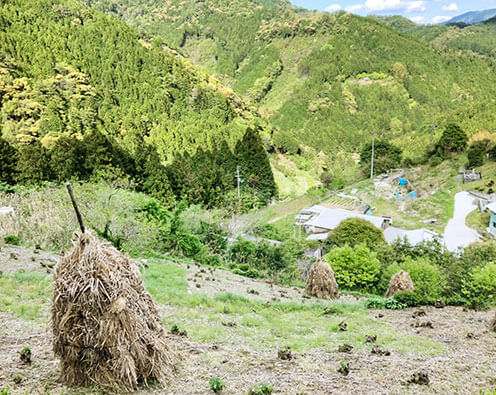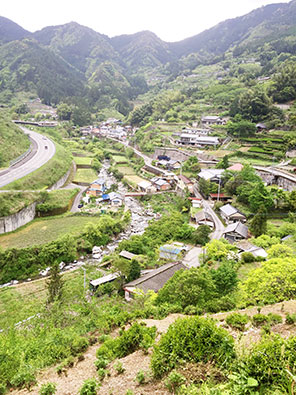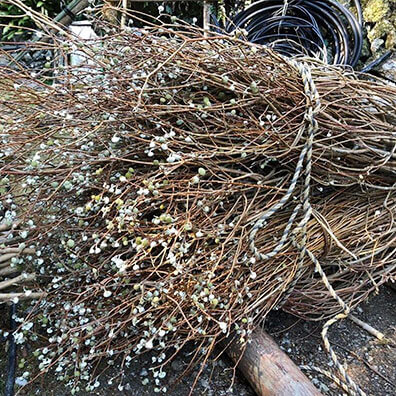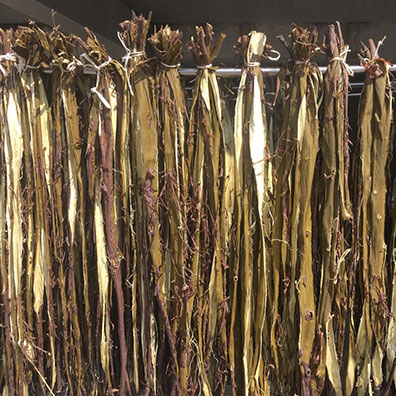Kashiki Paper Co., Ltd - Paper mill company supporting and nurturing the “Town of Washi”

高知大学講師 田中求 Kochi University Lecturer TANAKA Motomu
豊富な雨量と日照、きれいな水と空気、そして水はけの良い傾斜地を好む楮や三椏などの和紙原料産地にも恵まれた高知県は、様々な和紙を生産してきました。
鹿敷製紙のある仁淀川流域には、紙漉きやその道具、原料の生産、加工などに関わる人々が数多く暮らす「和紙の里」がたくさんあります。
日本各地に多くの和紙産地が形成されてきましたが、原料の多くを地域外から買っている産地がほとんどであり、仁淀川流域ほど大きな和紙原料産地と多くの紙漉き工房が連なっている地域はありません。そのなかでも、最も地域の原料を大事にしてきたのが鹿敷製紙ではないかと思います。
Kochi prefecture is blessed with raw materials used in washi practices, such as kozo (paper mulberry) and mitsumata and has produced various types of washi. These raw materials were nurtured under abundant rain and sunshine, clear water and air, and well-drained slope surfaces. Around Niyodo river where Kashiki Paper Co., Ltd is located, there is a “town of washi” where people make their living by producing paper or papermaking tools, harvesting or processing raw materials.
During the old times, paper mill companies and raw material farms coexisted together, but now most regions import their materials. There is no other place like Niyodo river area where harvesting sites and paper mill companies coexist on a large scale. Out of many papermills in this region, I believe Kashiki Paper Co., Ltd is the best company that has valued using local materials.


戦後の植林や茶・果樹などへの転作、昭和50年(1975)の台風5号被害などにより、高知県内の和紙原料は減少しました。全国的に海外からの輸入原料を利用する産地が増加するなかで、鹿敷製紙は高知県を中心とする国産原料のみを利用してきた数少ない会社です。
国内の各産地で、用途に応じて様々な原料や道具、技術を用いて数多くの種類の「紙」が漉かれていているなかで、海外から輸入された紙は「洋紙」と呼ばれ、それに対して国内で漉かれた紙が「和紙」と呼ばれるようになりました。しかしながら、多くの種類があり、次々と新たな技術や原料、用途が加わり、変化しつつある「和紙」を簡略に定義することは難しく、「和紙」とは何かが曖昧なままになっています。
In Kochi prefecture, the decline in raw material harvesting happened during post-war period when farmers changed their crops to tea, fruits and/or afforestation. The typhoon in 1975 that affected the area also made farmers move away from raw material harvesting. Kashiki Paper Co., Ltd is one of the few companies that utilizes local materials made in Kochi prefecture. Most companies in Japan have increased their dependency on importing the materials.
Paper made in Japan are called “washi” whereas imported paper is called “yo-shi (Western paper)”. There are various types of “paper” made in different areas of Japan, where materials, tools and techniques differ depending on its usage. The definition of “washi” is still vague, and it is not easy to explain them in simple words. Types of washi are changing overtime along with new techniques, materials and usages.


「洋紙」と「和紙」の違いを製法などから細かく分類することもできるかもしれませんが、違いとしてわかりやすいのは、どこで・誰が・どの原料を使って作っているのか、ということではないかと思います。鹿敷製紙は、仁淀川流域で培われてきた技術を受け継ぎ、また新たな技術を開発しながら、地域の原料農家さんや加工技術者さん、紙漉きさん、問屋さんたちとのつながりを基盤に和紙を漉き(すき)続けることを最も大事にしてきた会社なのです。
鹿敷製紙の和紙には、何世代にもわたって楮や三椏などを作り続けてきた農家さんや原料の加工を担ってきた方たち、流通や販売に関わる多くの方たちの想いが詰まっているように思います。鹿敷製紙の和紙は、たくさんの想いと物語、人と地域と自然のつながりのなかで、生み出されてきたのでしょう。
We may categorize in detail what “yo-shi” and “washi” are by looking at their production method. The easiest way to distinguish them is by understanding where/who/what materials are used to produce paper. Kashiki Paper Co., Ltd puts importance on relationships with raw material farmers, processors, producers, and dealers in their region. They have also passed down its technologies nurtured in Niyodo river area and developed new ones overtime.
I believe that the relationship between people, community and nature along with many background stories and hopes have contributed to the production of washi at Kashiki Paper Co., Ltd. I feel the genuine hearts of farmers, who have produced kozo and mitsumata for many generations, processors of raw materials, distributors and sales. Their thoughts are embodied into the washi.

地域の多くの方たちの想いを背負い、そして確かな原料と技術で作られた信頼に足る和紙を求める国内外の方たちの声に応え続けることには、多くの困難が伴うかと思います。しかしながら、それは国内最大の原料産地であり、和紙作りに最適な気候風土に恵まれた仁淀川流域にある鹿敷製紙に課せられた義務なのかもしれません。
鹿敷製紙の益々の発展と、「和紙の里」としての仁淀川流域の里・川・山のつながりが受け継がれていくことを心から祈念しております。
The company may face various obstacles while meeting expectations of local people and responding to the voices of domestic and overseas users who request for a trusting quality with assured materials and techniques. Nevertheless, it is the company’s responsibility to hear those voices. The company is located near the beautiful Niyodo river where weather and nature are suitable for washi production, and where the area has the largest raw material harvesting site.
I sincerely hope for the continuous growth of Kashiki Paper Co., Ltd and that the town, rivers and mountains near the Niyodo river area continue to coexist and for this coexistence to be passed down for many generations.


